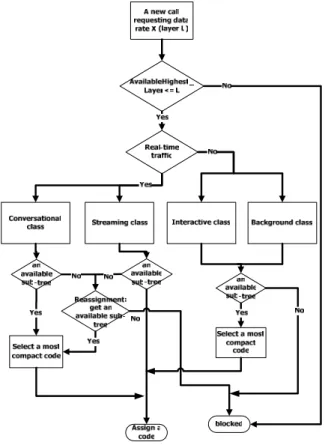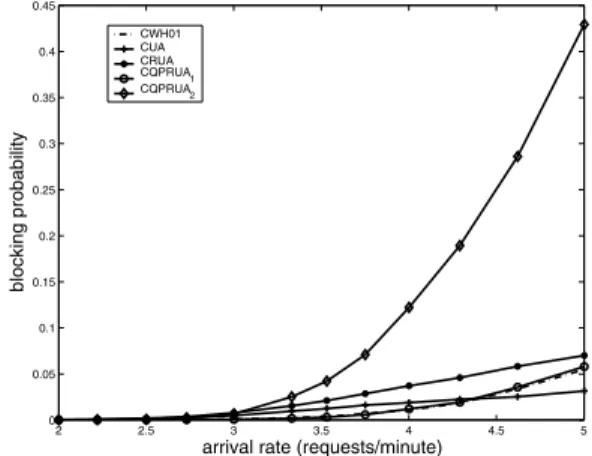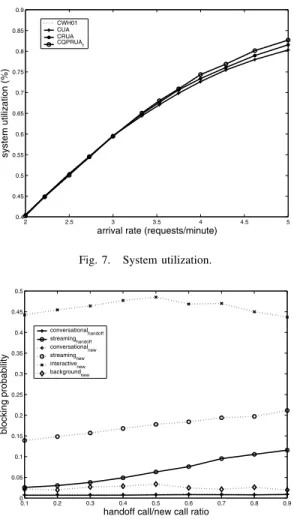OVSF Code Tree Management for UMTS with Dynamic Resource Allocation
and Class-Based QoS Provision
Huei-Wen Ferng, Jin-Hui Lin, Yuan-Cheng Lai † , and Yung-Ching Chen Department of Computer Science and Information Engineering National Taiwan University of Science and Technology, Taipei 106, Taiwan
†
Department of Information Management
National Taiwan University of Science and Technology, Taipei 106, Taiwan E-mail: hwferng@mail.ntust.edu.tw
Abstract— Rather than simply keeping the code tree as com- pact as possible merely depending on the request rate, we design a scheme on the orthogonal variable spreading factor (OVSF) code tree management for the universal mobile telecommunication system (UMTS) by further considering characteristics of traffic and dynamic resource allocation (DRA) to make the management efficient and satisfy different quality-of-service (QoS) require- ments requested by diverse multimedia applications. Through simulations, we demonstrate that the proposed scheme can not only adequately take care of QoS requirements but also significantly reduce the number of code reassignment, making it charming and more suitable for the real and complicated system.
I. I NTRODUCTION
Compared to the second generation (2G) mobile commu- nication systems, which mainly provide voice and low-rate data transmission, the third generation (3G) ones are targeted to provide high-rate transmission for multimedia applications.
To fulfill the goal, UMTS employs wide-band code division multiple access (WCDMA) to support multi-rate applications utilizing OVSF codes. Then, how to efficiently manage the code tree becomes a research issue [2]–[10] because of code fragments, resulting in code blocking [2] although the capacity is still enough. The situation gets worse when requested rates are diverse. In [2], a dynamic assignment scheme was designed to solve code blocking and minimize the number to reassign OVSF codes. The authors showed that the proposed scheme can not only reduce the blocking probability but also increase the system utilization. [3] proposed two strategies, called leftmost and crowded-first, to reduce the call blocking probability as well as the code reassignment cost for multi- rate services. The OVSF code tree management schemes proposed by [2] and [3] focus on single type of services rather than multiple services. To consider multiple services and differentiated QoS requirements, [4] proposed the scheme described as follows: the code tree is divided into different regions for voice and video services so as to guarantee certain degree of QoS (but this will reduce the system utilization).
Similar to [4], [5] proposed a new scheme to take care
of users with different rate requirements by evaluating call blocking probability and number of reassignments. Taking four service classes specified in the 3GPP standard [1], i.e., conversational, streaming, interactive, and background classes into consideration, traffic classes in [6] are grouped into high- rate and low-rate ones. The high-rate traffic takes the OVSF code from the left-hand side and the low-rate traffic takes the OVSF code from the right-hand side. By reassigning codes once a code is released and endowing with queues for the delay-tolerable traffic, the proposed scheme can improve the performance for the streaming traffic, but it increases the reassignment cost. [7] allocates codes based on a compact index to keep the code tree as compact as possible. This compact index represents the distribution of neighboring codes but it needs to be recalculated before code assignments. To improve system utilization, [8] presented a dynamic OVSF code assignment algorithm that efficiently shares resources among traffic with diverse requirements. As for the scheme proposed in [9], it only supports delay-tolerant traffic and constructs the code tree according to the number of users in the system. It would be useful to maximize the transmission rate in the homogeneous communication situation as suggested by simulation results. Finally, [10] provided a framework of traffic conditioning with QoS provisioning in the 3G radio access network, which employs traffic shaping at each user equipment (UE) and traffic policing at the radio network controller (RNC).
In the literature, both single-code and multi-code OVSF
code assignments are proposed to support multi-rate trans-
mission. However, we focus on the single-code one in this
paper because of its simplicity in the hardware design. We
take multimedia applications with differentiated QoS into
account. According to the 3GPP specification [1], the four
service classes are also considered. Moreover, DRA in UMTS
terrestrial radio access network (UTRAN) is included to
guarantee QoS for multimedia applications. The ideas for the
proposed scheme are briefly described as follows. Based on
the requested rate by the traffic, this scheme can keep the
OVSF code tree as compact as possible in a new way with prioritized classes to reduce code blocking and the number of reassignments. Using the DRA scheme, queues and service priorities for different classes are incorporated. By doing so, we can demonstrate that our scheme performs well and is more suitable for real and complicated systems as compared to [6]
which is the closest paper to ours in the literature.
The rest of the paper is organized as follows. Section II describes the proposed scheme. Then, numerical examples and discussions are given in Section III. Finally, Section IV concludes the paper.
II. D ESCRIPTION OF THE P ROPOSED S CHEME
The proposed scheme consists of three parts. The first part is OVSF code tree segmentation. The second part concerns the OVSF code assignment (with or without reassignment), including class-based unit assignment (CUA) and class-based rearrangeable unit assignment (CRUA). Finally, the dynamic resource allocation forms the third part.
A. OVSF Code Tree Segmentation
After a period of operation, available codes will be scattered around the code tree. This definitely affects the performance of the system. Hence, keeping the code tree as compact as possible is a general goal to manage the code tree well. In our scheme, we divide the code tree into sub-trees (assignment units) according to the highest requested rate by the service class, i.e., 16 R, the requested rate of the streaming class, where R is the requested rate of the conversational class. Therefore, the whole tree with capacity of 256 R is divided into 16 sub- trees. Fig. 1 illustrates the 16R-based code tree segmentation.
Unlike regions used by [4], sub-trees are not reserved for any particular class but are used to facilitate the code tree management. For example, ongoing calls in an sub-tree can be moved to other sub-trees if code blocking happens. Also, the computation complexity can be kept at a low level and radio resources can be efficiently utilized with the code tree segmentation.
Fig. 1. OVSF code tree segmentation.
B. Class-Based Unit Assignment (CUA) and Class-Based Re- arrangeable Unit Assignment (CRUA)
Let us first describe the procedure of CUA as follows:
1) Since the streaming class requests the highest rate, they will take an assignment unit at a time. Giving an arriving call belonging to the streaming class, assign a randomly chosen unit to the new call if there are still available assignment units; otherwise, block the call.
2) For an arriving call not belonging to the streaming class, choose an available assignment unit occupied by the most calls of the same requested rate or block the call.
After choosing an assignment unit, code selection will be performed. In this paper, we adopt the compact index denoting the relationship between codes proposed by [7] to select a code so that a compact subtree/tree is formed. In this way, the calls belonging to the same class will be put together. This can be regarded as a partial crowded-first strategy and can reduce the possibility of code blocking.
As mentioned earlier, the dynamic nature of code usage eventually affects the code status. Hence, even though we do our best to keep the code tree as compact as possible, multi- rate traffic can easily lead to code fragments, resulting in code blocking. Therefore, rearranging ongoing calls is inevitable to improve the system performance and to make the utilization high. Considering a state change of the code tree, CRUA perform the rearrangement procedure at an arrival epoch.
Also, with differentiated QoS constraints for different traffic classes, CRUA rearranges delay-sensitive (real-time) ongoing calls only, i.e., calls of conversational and streaming classes.
The algorithm of CRUA is depicted as follows (also shown diagrammatically in Fig. 2):
1) If a new real-time call arrives and code blocking hap- pens, choose a sub-tree with the least occupied calls and swap the ongoing calls to other sub-trees. The procedure continues iteratively from codes in the leaves.
2) If the chosen sub-tree can accommodate the new real- time call after the above procedure, the arriving real-time call uses a code within this sub-tree; else, block the call.
3) If code blocking happens but the new call is not delay- sensitive, i.e., non-real-time, then no reassignment is performed.
C. Dynamic Resource Allocation
DRA is a good approach to fulfill differentiated QoS. With DRA, we can set different priorities to different services.
Services with the highest priority can access the resource first. Also, queues can be employed for non-real-time ser- vices to reduce the blocking probability of non-real-time services. However, with limited resources, there are always some tradeoffs. For example, when the blocking probability for high-rate services decreases, the blocking probability for low-rate services may (slightly) increase. Due to the delay- sensitive property, real-time services should be quickly served, while non-real-time services can endure a bit longer delay. In general, DRA can improve the whole system performance for multimedia applications.
Now, how to apply priorities and queues is depicted as follows:
•
Priorities: To ensure QoS requirements, real-time traffic
of conversational and streaming classes should always
have higher priorities over non-real-time traffic of inter-
active and background classes. As aforementioned, non-
real-time services can endure longer delay time and this
Fig. 2. CRUA Algorithm.
gives real-time services a chance to get an available code.
Moreover, if new calls and handoff calls are considered separately, handoff calls of conversational and stream- ing classes should have higher priorities over new calls of these two classes, whose priorities are subsequently higher than other calls because of the real-time nature and the fact that less satisfaction is raised by handoff failure than new call blocking.
•
Queues: This strategy can reduce blocking probabilities for non-real-time services at the expense of delay time of non-real-time services. But it is acceptable since longer delay can be tolerated by non-real-time services. To work with the priority strategy, we employ the following useful rules involved queues:
1) If the system load exceeds a preset threshold (T
nr, where
nrdenotes non-real-time), non-real-time traf- fic is forced to enter the queue first. During staying in the queue, the non-real-traffic can re-gain the resource if the system load falls below the threshold.
2) For higher priority traffic, such as handoff calls and real-time traffic, the traffic is forced to enter the queue when there is not any available code after the reassignment. During staying in the queue, this call can immediately be served once the system load falls below a preset threshold for the corresponding traffic (T
conand T
str, where
conand
strdenote con- versational and streaming, respectively) and there is
an available code after the reassignment.
Applying DRA strategies, we propose a new scheme called classed-based QoS provisioning rearrangeable unit assignment (CQPRUA), which includes three variants, i.e., CQPRUA
1, CQPRUA
2and CQPRUA
3. CQPRUA
1is de- signed based on CRUA but queues for non-real-time traffic are added. CQPRUA
2further employs queues for conversational and streaming classes as compared to CQPRUA
1. At last, CQPRUA
3differentiates handoff calls and new calls.
III. N UMERICAL E XAMPLES AND D ISCUSSIONS
In the following, we use a simulation approach to study the performance of schemes we proposed and and the scheme proposed in [6] (denoted by CWH01), including call blocking probability, system utilization, and the number of reassign- ments. In addition, we also show how the ratio of handoff calls and new calls affects the performance of various service classes.
A. Simulation Parameters
We assume the total capacity for the system is 256 R, where R is the basic rate and is approximately equal to 8 Kbits/sec. For each traffic classes, we use Poisson processes to model the arrivals (the mean arrival rate is varied from 2 to 5 (requests/minute). In addition, all the four service classes are mutually independent and have their own queue, if any.
In Table I, we summarize detailed parameters about traffic classes.
TABLE I S
IMULATION PARAMETERSservice type data rate service time timeout period buffer size
conversational 1R 180 sec. 10 sec. 4
streaming 16R 180 sec. 100 sec. 4
interactive 4R 10 sec. 360 sec. ∞
background 2R 5 sec. 3600 sec. ∞
B. Simulation Results
In Figs. 3–6, we compare the proposed schemes with the scheme proposed in [6] and show blocking probabilities for the four service classes, respectively. Fig. 3 shows the new call blocking probability for the conversational class.
From this figure, we observe that CQPRUA
1performs almost
equivalently to CWH01 and is inferior to CRUA, CQPRUA
2,
and CUA. Since a rearrangement policy, which rearranges
codes for real-time traffic, is employed in CRUA, CQPRUA
1,
and CQPRUA
2, it will assign available codes to the high-rate
real-time traffic, i.e., streaming class, thus increasing new call
blocking probability for the low-rate traffic. As for the compar-
ison between CQPRUA
1and CQPRUA
2, CQPRUA
2performs
better because of the setting of queues. Similarly, new call
blocking probability for the streaming class using CQPRUA
2is still better than that using CQPRUA
1. In fact, CQPRUA
2outperforms other schemes because of the implementation of
the rearrangement policy, priority and queue as shown in In
Fig. 4. In Figs. 5 and 6, the new call blocking probabilities for
2 2.5 3 3.5 4 4.5 5 0
0.005 0.01 0.015 0.02 0.025 0.03
arrival rate (requests/minute)
blocking probability
CWH01 CUA CRUA CQPRUA
1 CQPRUA 2
Fig. 3. New call blocking probabilities among different schemes for the conversational service type.
interactive and background traffic are examined for different schemes. As shown in Fig. 4, we note that the rearrangement policy is indeed good for CQPRUA
1and CQPRUA
2. However, CQPRUA
1and CQPRUA
2downgrade performance of other traffic. This tradeoff can be easily examined from Figs. 3 and 5. Fig. 7 shows the system utilization for different schemes.
We witness that CQPRUA
1performs better than CRUA and CUA.
To decrease the code tree fragments resulting from allocat- ing and releasing codes, reallocation of ongoing calls is an imperative procedure to enhance system performance. In [6], allocated codes are reallocated once a code is released and the procedure is performed recursively to find an adequate code for the tree-structure codes. However, we implement the reallocation at the arrival epoch for delay-sensitive traffic only in our proposed schemes to reduce the cost of reassignments.
In Table II, we show that the proposed scheme can greatly reduce the number of reassignments (about 100% of improve- ment) although CQPRUA
1and CWH01 [6] almost have the same performance as shown in Figs. 3–7.
To further apply the proposed scheme to real systems, the discrimination between handoff calls and new calls is necessary and is incorporated into CQPRUA
3. Fig. 8 shows the performance under different ratios of handoff calls and new calls with the total arrival rate of 5 requests/minute. As the arrival rate of handoff calls increases, the blocking probability for the handoff streaming traffic increases naturally; so does that for the new streaming traffic because of lower priority and higher rate requested. In addition, handoff and new conversational traffic streams get served due to low requested rate and background class can have a low blocking probability since longer delay is acceptable when applying a queue. As for the blocking probability for the interactive class, it increases first when resources are taken by traffic with higher priorities, but it then decreases because of the left fragments.
IV. C ONCLUSIONS
This paper proposes a new scheme CQPRUA (containing three variants) for the OVSF code tree management by taking
2 2.5 3 3.5 4 4.5 5
0 0.05 0.1 0.15 0.2 0.25
arrival rate (requests/minute)
blocking probability
CWH01 CUA CRUA CQPRUA
1 CQPRUA
2
Fig. 4. New call blocking probabilities among different schemes for streaming service type.
2 2.5 3 3.5 4 4.5 5
0 0.05 0.1 0.15 0.2 0.25 0.3 0.35 0.4 0.45
arrival rate (requests/minute)
blocking probability
CWH01 CUA CRUA CQPRUA1 CQPRUA 2
Fig. 5. New call blocking probabilities among different schemes for interactive service type.
2 2.5 3 3.5 4 4.5 5
0 0.005 0.01 0.015 0.02 0.025 0.03 0.035 0.04 0.045 0.05
arrival rate (requests/minute)
blocking probability
CWH01 CUA CRUA CQPRUA
1 CQPRUA
2
Fig. 6. New call blocking probabilities among different schemes for background service type.
TABLE II N
UMBER OF REASSIGNMENTSarrival rate 2 3 4 5
CWH01 24158.1 41754.3 65186.9 90737.4
CQPRUA
10.7 74.2 702.8 2046.1
2 2.5 3 3.5 4 4.5 5 0.4
0.45 0.5 0.55 0.6 0.65 0.7 0.75 0.8 0.85 0.9
arrival rate (requests/minute)
system utilization (%)
CWH01 CUA CRUA CQPRUA
1
Fig. 7. System utilization.
0.1 0.2 0.3 0.4 0.5 0.6 0.7 0.8 0.9
0 0.05 0.1 0.15 0.2 0.25 0.3 0.35 0.4 0.45 0.5
handoff call/new call ratio
blocking probability
conversational handoff streaming
handoff conversational
new streaming
new interactive
new background
new


